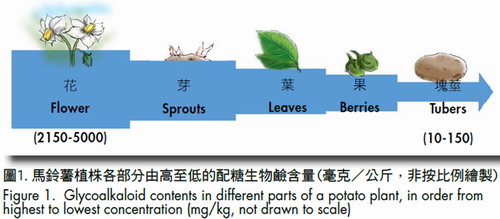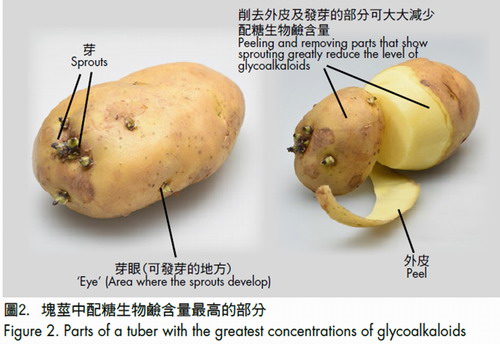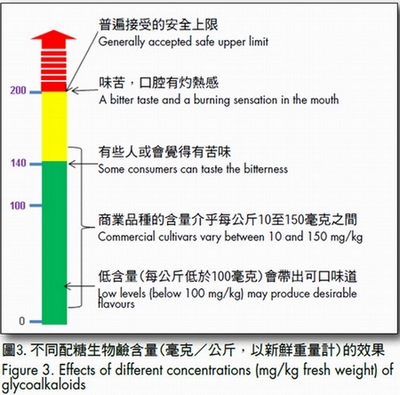
Food Safety Focus (112th Issue, November 2015) – Incident in Focus
Toxic Glycoalkaloids in Potatoes
Mr. Johnny CHU, Scientific Officer,
Risk Assessment Section,
Centre for Food Safety
In September 2015, the Centre for Food Safety (CFS) was notified of a food poisoning case involving two persons from the same household. They developed tongue numbness and a burning sensation in their mouths immediately after eating cooked potatoes prepared at home on the evening of 17 September 2015. Both sought medical treatment but did not require hospitalisation. They were in stable condition and their symptoms gradually resolved. Solanine was detected in the raw potato sample provided by the household and in a urine sample of one of the victims. The findings were compatible with solanine poisoning. Potatoes are known to contain glycoalkaloids which may induce gastrointestinal and systemic effects if consumed in high amounts. Local consumers are seldomly exposed to levels of glycoalkaloids that cause serious health effects. However, there have been in the past occasional reports of short-term adverse symptoms, usually from eating potatoes that contain elevated amount of glycoalkaloids.
Glycoalkaloids in Potatoes
Glycoalkaloids are naturally produced in potatoes (Solanum tuberosum) and the main glycoalkaloids are alpha-solanine and alpha-chaconine which together account for 95% of the total glycoalkaloid content.
Glycoalkaloids occur in all parts of a potato plant. The highest glycoalkaloid levels are found in flowers and sprouts while the lowest is in potato tubers. According to literature, the total glycoalkaloid content of commercial cultivars of tubers may vary between 10 and 150 mg/kg fresh weight (Figure 1).

Glycoalkaloids are found throughout the potato tubers, but concentrate in the sprouts, peel and the area around the potato ‘eyes' (Figure 2). In normal tubers, glycoalkaloids are concentrated in a small 1.5 mm layer immediately under the skin (i.e. 30 to 80% of the glycoalkaloids are found in the outer peel). According to a study conducted by the CFS in 2007, the glycoalkaloid content (alpha-solanine and alpha-chaconine) of five cultivars of tubers available in the Hong Kong market ranged from 26 to 88 mg/kg fresh weight. While glycoalkaloids were below 10 mg/kg in the flesh of these potatoes, glycoalkaloids in the peel varied between 90 and 400 mg/kg. Hence, with normal tubers, peeling of potatoes will greatly reduce the levels of glycoalkaloids present.

Increase of Glycoalkaloids During Storage
Prolonged exposure of potato tubers to light on the store shelf or at home will stimulate the occurrence of two independent reactions near the surface of the potato tuber: the formation of green colour and glycoalkaloids. The appearance of green colour is called "greening" and it indicates the formation of chlorophyll. Since the formation of chlorophyll and glycoalkaloids occurs side by side, "greening" is considered to be an indication for an increase in the level of glycoalkaloids.
Damage to tubers also causes increased synthesis of glycoalkaloids; hence, damaged potatoes on the store shelf generally contain elevated levels of glycoalkaloids.
Public Health Significance
High levels of glycoalkaloid are toxic to humans. Acute symptoms, which generally occur 30 minutes to 12 hours after ingestion, include nausea, vomiting, stomach and abdominal cramps, and diarrhoea. More severe cases of glycoalkaloid poisoning may be accompanied by a variety of neurological effects (i.e. drowsiness, restlessness, shaking, confusion, weakness, and disturbed vision). However, it is unlikely that humans would eat potatoes containing high, fatal glycoalkaloid doses because glycoalkaloid concentrations above 200 mg/kg are associated with a bitter taste and a burning sensation in the throat and mouth (Figure 3).

Regulatory Control
Codex has not established any food safety standard for glycoalkaloid levels in food; however, the generally accepted safe upper limit is considered to be 200 mg glycoalkaloids per kg of fresh potato. There is no specific regulation on glycoalkaloids in food stipulated in the laws of Hong Kong. Nevertheless, all foods for sale in Hong Kong must be fit for human consumption.
Actions Taken
Upon the notification of the food poisoning case, the retailer was instructed to withdraw the potatoes concerned off the shelves.
Preventive Measures
While levels of glycoalkaloids in commercial potato varieties are unlikely to cause adverse health effects, improper storage (e.g. exposure to light) or damage to the tubers can lead to rapid production of glycoalkaloids. The increased glycoalkaloid content cannot be significantly reduced by cooking (i.e. baking, boiling, frying, and microwaving) because glycoalkaloids are heat stable and only begin to break down between 230oC and 280oC. Hence, the public is advised to store potatoes properly (i.e. in a cool, dry, dark place). To reduce the amount of glycoalkaloids in potatoes, the public is also advised to peel the skin and to remove the parts of the tuber that show damage, rotting, green colouring and sprouting before cooking. In more severe cases, discard the entire potato.
Key Points to Note:
- Glycoalkaloids occur naturally in potatoes and are toxic to humans at high levels.
- Glycoalkaloids are concentrated in the peel and prolonged exposure of tubers to light will stimulate the formation of glycoalkaloids near the surface of the potato tuber.
- Glycoalkaloids are not broken down by cooking or frying.
Advice to the Trade
- Display potato tubers in areas with low light intensity. Shut lights off at night over the potatoes, or cover the potatoes with brown paper sacks.
- Keep potatoes cool and dry.
Advice to the Public
- Buy on an "as needed" basis to avoid the need for long-term storage.
- Store potatoes in a cool, dry, dark place.
- Peel the potatoes before cooking can reduce the amount of glycoalkaloids.
- Cut away any parts that show damage (cuts and bruises), rotting, green colouring and sprouting before cooking. In severe cases, discard the entire potato.
- Do not eat potatoes that taste bitter or cause a burning sensation in the mouth.

